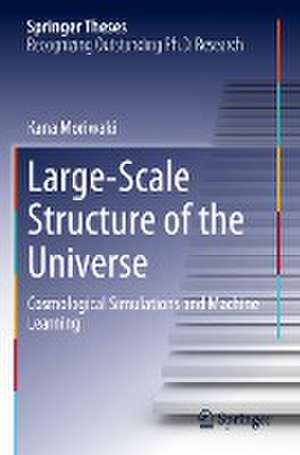Large-Scale Structure of the Universe: Cosmological Simulations and Machine Learning: Springer Theses
Autor Kana Moriwakien Limba Engleză Paperback – 3 noi 2023
| Toate formatele și edițiile | Preț | Express |
|---|---|---|
| Paperback (1) | 936.95 lei 6-8 săpt. | |
| Springer Nature Singapore – 3 noi 2023 | 936.95 lei 6-8 săpt. | |
| Hardback (1) | 942.76 lei 6-8 săpt. | |
| Springer Nature Singapore – 2 noi 2022 | 942.76 lei 6-8 săpt. |
Din seria Springer Theses
- 18%
 Preț: 997.88 lei
Preț: 997.88 lei -
 Preț: 389.88 lei
Preț: 389.88 lei - 15%
 Preț: 646.94 lei
Preț: 646.94 lei - 18%
 Preț: 943.43 lei
Preț: 943.43 lei -
 Preț: 399.29 lei
Preț: 399.29 lei - 18%
 Preț: 944.99 lei
Preț: 944.99 lei - 15%
 Preț: 636.80 lei
Preț: 636.80 lei - 18%
 Preț: 941.05 lei
Preț: 941.05 lei - 15%
 Preț: 643.16 lei
Preț: 643.16 lei - 15%
 Preț: 642.68 lei
Preț: 642.68 lei - 18%
 Preț: 1103.62 lei
Preț: 1103.62 lei - 20%
 Preț: 558.83 lei
Preț: 558.83 lei - 18%
 Preț: 1112.30 lei
Preț: 1112.30 lei - 18%
 Preț: 944.19 lei
Preț: 944.19 lei - 18%
 Preț: 1109.92 lei
Preț: 1109.92 lei - 18%
 Preț: 1217.27 lei
Preț: 1217.27 lei - 15%
 Preț: 640.06 lei
Preț: 640.06 lei - 15%
 Preț: 636.45 lei
Preț: 636.45 lei - 15%
 Preț: 640.06 lei
Preț: 640.06 lei - 15%
 Preț: 640.88 lei
Preț: 640.88 lei -
 Preț: 389.70 lei
Preț: 389.70 lei - 20%
 Preț: 563.91 lei
Preț: 563.91 lei -
 Preț: 393.35 lei
Preț: 393.35 lei - 15%
 Preț: 637.93 lei
Preț: 637.93 lei - 15%
 Preț: 641.85 lei
Preț: 641.85 lei - 18%
 Preț: 1225.94 lei
Preț: 1225.94 lei - 20%
 Preț: 551.36 lei
Preț: 551.36 lei - 18%
 Preț: 1229.10 lei
Preț: 1229.10 lei - 15%
 Preț: 639.25 lei
Preț: 639.25 lei - 18%
 Preț: 999.45 lei
Preț: 999.45 lei - 15%
 Preț: 640.06 lei
Preț: 640.06 lei - 18%
 Preț: 1220.45 lei
Preț: 1220.45 lei - 18%
 Preț: 1116.26 lei
Preț: 1116.26 lei - 18%
 Preț: 1110.72 lei
Preț: 1110.72 lei - 18%
 Preț: 1000.87 lei
Preț: 1000.87 lei - 18%
 Preț: 891.17 lei
Preț: 891.17 lei - 15%
 Preț: 640.06 lei
Preț: 640.06 lei - 5%
 Preț: 1154.07 lei
Preț: 1154.07 lei - 15%
 Preț: 635.96 lei
Preț: 635.96 lei - 15%
 Preț: 640.88 lei
Preț: 640.88 lei -
 Preț: 387.20 lei
Preț: 387.20 lei - 18%
 Preț: 1109.92 lei
Preț: 1109.92 lei -
 Preț: 385.25 lei
Preț: 385.25 lei -
 Preț: 385.25 lei
Preț: 385.25 lei - 18%
 Preț: 1112.30 lei
Preț: 1112.30 lei - 18%
 Preț: 999.45 lei
Preț: 999.45 lei -
 Preț: 386.99 lei
Preț: 386.99 lei - 15%
 Preț: 637.13 lei
Preț: 637.13 lei - 20%
 Preț: 554.21 lei
Preț: 554.21 lei - 20%
 Preț: 555.59 lei
Preț: 555.59 lei
Preț: 936.95 lei
Preț vechi: 1142.62 lei
-18% Nou
Puncte Express: 1405
Preț estimativ în valută:
179.29€ • 191.72$ • 149.48£
179.29€ • 191.72$ • 149.48£
Carte tipărită la comandă
Livrare economică 18 aprilie-02 mai
Preluare comenzi: 021 569.72.76
Specificații
ISBN-13: 9789811958823
ISBN-10: 9811958823
Pagini: 120
Ilustrații: XII, 120 p. 46 illus., 44 illus. in color.
Dimensiuni: 155 x 235 mm
Greutate: 0.2 kg
Ediția:1st ed. 2022
Editura: Springer Nature Singapore
Colecția Springer
Seria Springer Theses
Locul publicării:Singapore, Singapore
ISBN-10: 9811958823
Pagini: 120
Ilustrații: XII, 120 p. 46 illus., 44 illus. in color.
Dimensiuni: 155 x 235 mm
Greutate: 0.2 kg
Ediția:1st ed. 2022
Editura: Springer Nature Singapore
Colecția Springer
Seria Springer Theses
Locul publicării:Singapore, Singapore
Cuprins
Introduction.- Observations of the Large-Scale Structure of the Universe.- Modeling Emission Line Galaxies.- Signal Extraction from Noisy LIM Data.- Signal Separation from Confused LIM Data.- Signal Extraction from 3D LIM Data.- Application of LIM Data for Studying Cosmic Reionization.- Summary and Outlook.- Appendix.
Notă biografică
Kana Moriwaki is an assistant professor in the School of Science at the University of Tokyo. She received her Ph.D. from the University of Tokyo in 2022 and was awarded the University of Tokyo President's Grand Prize. Her interest lies in cosmological simulations and the application of machine learning techniques for astronomical data.
Textul de pe ultima copertă
Line intensity mapping (LIM) is an observational technique that probes the large-scale structure of the Universe by collecting light from a wide field of the sky. This book demonstrates a novel analysis method for LIM using machine learning (ML) technologies. The author develops a conditional generative adversarial network that separates designated emission signals from sources at different epochs. It thus provides, for the first time, an efficient way to extract signals from LIM data with foreground noise. The method is complementary to conventional statistical methods such as cross-correlation analysis. When applied to three-dimensional LIM data with wavelength information, high reproducibility is achieved under realistic conditions. The book further investigates how the trained machine extracts the signals, and discusses the limitation of the ML methods. Lastly an application of the LIM data to a study of cosmic reionization is presented. This book benefits students and researcherswho are interested in using machine learning to multi-dimensional data not only in astronomy but also in general applications.
Caracteristici
Nominated as an outstanding Ph. D. thesis by The University of Tokyo Offers a novel technique based on machine learning for analysis of astronomical observational data Develops conditional generative adversarial networks using physical information in data
